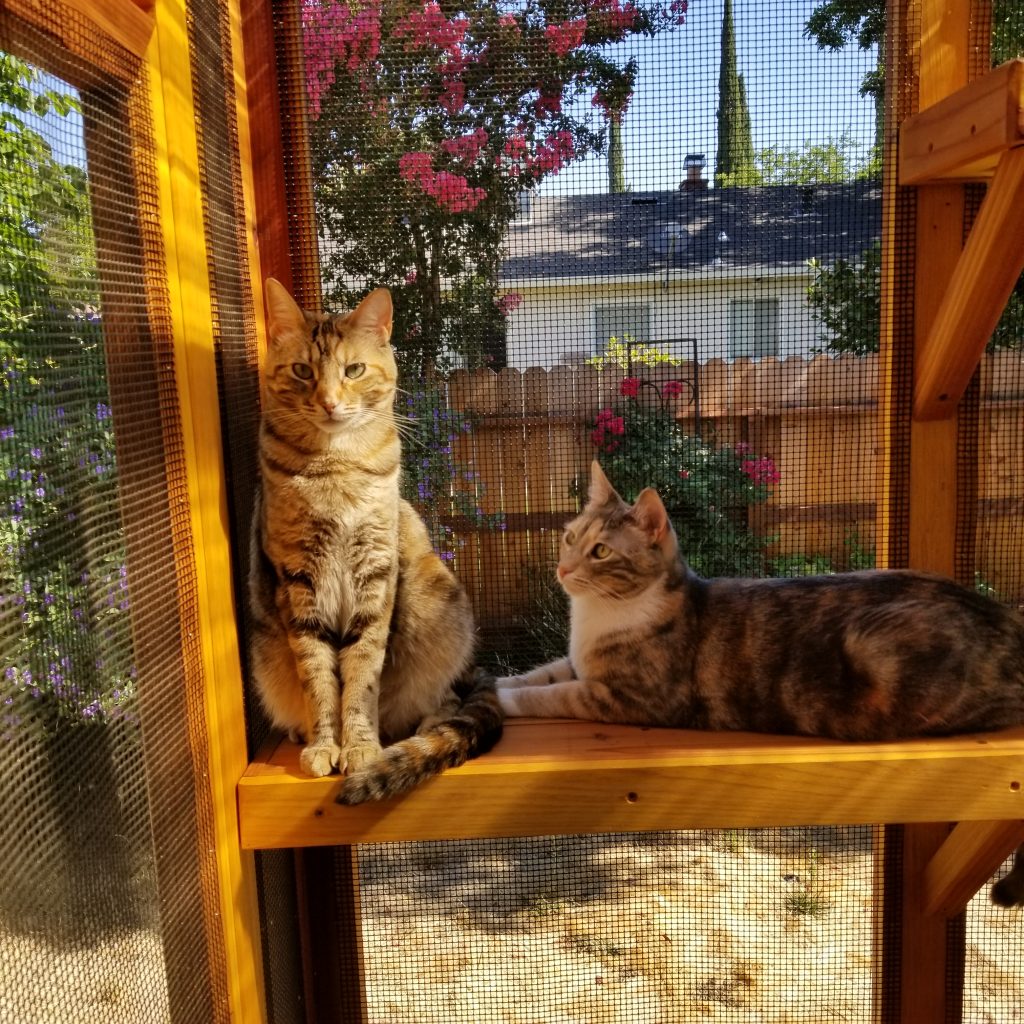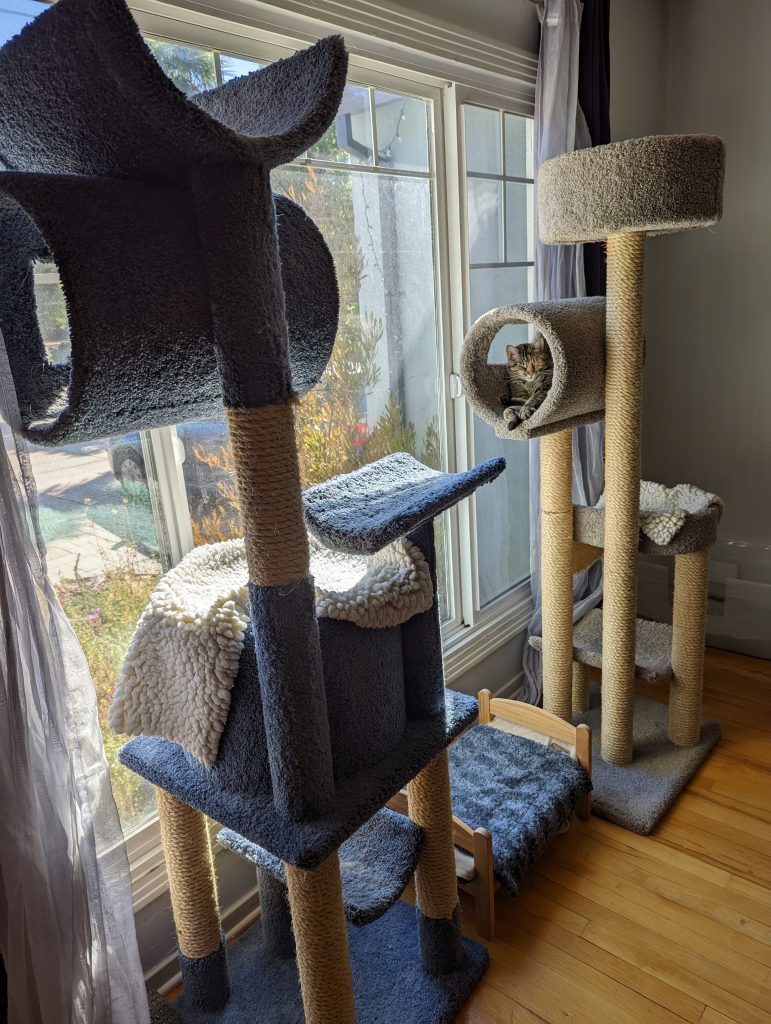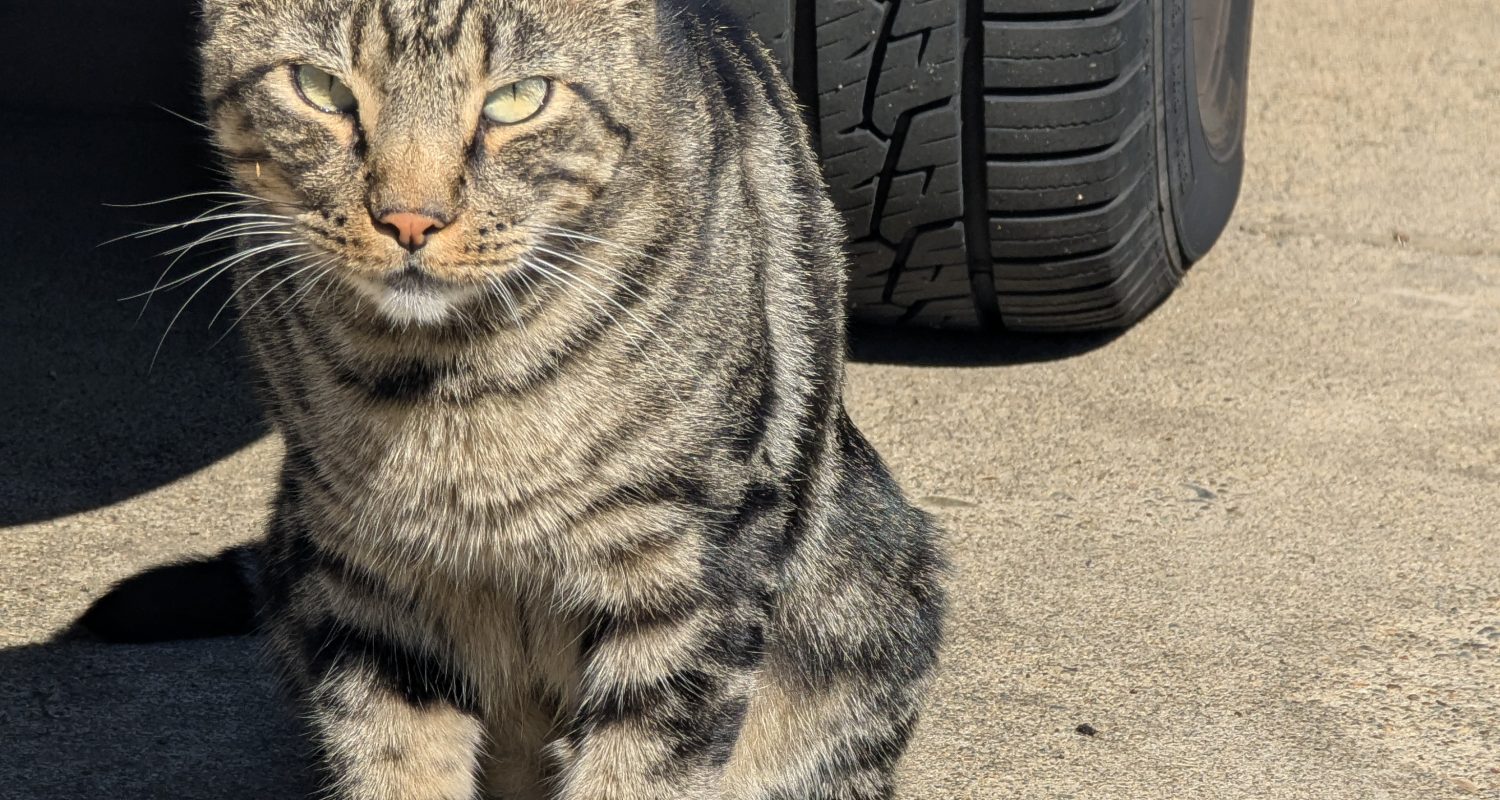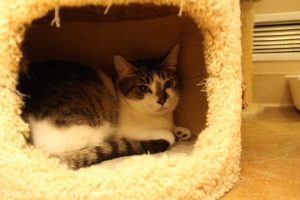New research looks at the challenges and successes of transitioning cats to indoors-only.
The biggest challenge for most cat behavior consultants is not changing cat behavior. It’s changing the behavior of the cat’s human. Researchers are now turning to human behavior change as a key to improving pet welfare. This has been explored in studies of:
- horse obesity
- trap-neuter-return (TNR) programs
- housing for exotic pets
- daily wand toy play with one’s cat (ahem, authored in part by yours truly and blogged about here).

In the United States, around 60% of us keep our cats indoors only, or with controlled access to the outdoors (e.g., in a catio or via harness walks). But in other areas of the world, allowing cats outdoor access is much more common.
We know that human habitat destruction and predation by other species contribute to songbird population decline. But we cannot deny that domestic cats also contribute to this ecological problem. And it’s not just about the birds! Cats who go outside may be injured and may also be a nuisance to neighbors. (Many of my clients with indoor-only cats who have been disturbed by the presence of outside cats in their yard can attest to this).
There are increasing calls to bring cats indoors, especially in areas such as New Zealand and Australia. In these areas, the impact of cats on predator-naïve species can be severe. However, many do not wish to bring their cats indoors! Reasons range from not wanting to maintain a litter box to feeling that cats are happier if they have access to the outdoors.
New research (Who let the cats in? Evaluation of the transitioning of cats to indoor life) looked at cat behavior AND caregiver feelings when transitioning cats to living exclusively indoors. The research, based in New Zealand, looked at how the transition to the indoors-only lifestyle affected cats. The researchers also wanted to hear from the cat caregivers about how they perceived the transition and its impact on their cat’s welfare.
Methods: What the researchers did
Getting participants turned out to be a challenge. Of the 114 people who expressed interest, 16 people (and their cats) enrolled in the study. The design of the study was as such:
- for the first week, participants maintained the usual routine of letting their cats go outside.
- for the last three weeks of participation, they kept their cats indoors.
Participants completed multiple surveys and kept a daily diary about their cat’s behavior. Cats were also fitted with activity monitors to track when cats were active or sleeping.
How did the cats respond to living indoors?
Post-confinement, owners did not report problematic behaviors (e.g., aggression, nighttime activity). The exception was increased scratching of objects in the home. The activity trackers did not find differences in the cats’ activity before and after confinement.
Out of the 15 cats whose caregivers completed the diaries, 10 of them were completely adjusted to their new, indoor-only lifestyle by day 21. “Adjusted” was defined as no perceived changes in behavior, and no escape attempts. Although some of these cats showed initial signs of stress, they eventually accepted being indoors.
As the caregivers reported: “chilled out and happy living the indoor life.” Five of the ten cats did not try to escape at any time. The other five tried to escape between 1 and 5 times during the three weeks of confinement. Five of these caregivers said it was very or somewhat likely they would keep their cat indoors after the study, whereas the other half said “nah.”
All five of the five cats that did NOT adjust to being indoors made many attempts to get outdoors. Some showed signs of stress (fear of the toddler/children in the home, increased hiding, excessive grooming). Two of these cats also urinated in the house. Only one participant from this group thought it was likely they would keep their cat indoors after the study.
How did people feel about keeping their cats indoors?
Caregivers were interested in the health and safety benefits of keeping their cats indoors. However, they expressed concerns about their cat’s well-being and felt their cats might be bored if indoors-only. People were interested in providing more enrichment or play for their cat, and enjoyed spending more time with their cat.
At the same time, caregivers also felt that keeping their cats indoors was no fun. They had to watch for escape attempts, especially with children or visitors coming and going. One person expressed that it was difficult to see her cat not able to join “her friends outside.” Others complained about not being able to open windows in warm weather. Some were frustrated with litter box avoidance, and others felt their cat was stressed around their children.
What happened six months later?
The researchers followed up with 13 of the participants six months after the study. Only three cats were still being kept indoors only. Interestingly, none of the people who had said they were likely to keep their cat indoors only were doing so six months later! People returned their cat to outdoor access due:
- perceived changes to their cat’s behavior
- the burden of trying to keep the cats indoors
- feeling that the cat’s personality and history made it too difficult to keep them indoors
Conclusions: Can cats be transitioned to indoors only?

Although most cats adapted to transitioning from outdoors to indoors, their caregivers did not! As cats are creatures of habit, it is not surprising that there were some initial signs of stress in the cats in this study. Honestly, I was surprised that so few of them had difficulties adapting. Their caregivers were not given any instructions about helping their cat adjust. For example, increasing resources or playtime may help some cats with the transition. Because cats were stressed at first, the authors suggest NOT transitioning a cat to living indoors when there are other stressors happening.
Cats may also need modification of the environment to adjust, especially if there are children or other pets in the home. More vertical spaces and hiding spaces could have helped the cats who seemed stressed by kids in the home. For these cats, being able to go outside may have helped them cope with the stress of living with children.
There were individual differences among the cats to how they responded to confinement. Yet, it does not appear that previous outdoor access was a predictor of cats’ ability to adapt to the indoors within a few weeks.
Conclusions: Can caregivers adjust to keeping their cats indoors only?
It appears that the caregivers struggled more than their cats with the transition. People who are considering transitioning their cats to indoors only need help. Basic behavior advice and environmental modifications could have helped cats adjust even faster. For example, many caregivers mentioned not being able to open windows in hot weather. This could be easily remedied with sturdy window screens.
The biggest challenge seems to be caregiver beliefs: if they felt it was detrimental to their cat’s welfare to keep them indoors, they were less likely to do so. This is true EVEN if they also held the belief that it was beneficial to wildlife. Previous studies have shown that cat safety is one of the bigger motivators for keeping cats indoors. (Basically, people feel bad for the birds, but they feel worse for their cats…and maybe for themselves).
This study was very interesting, but the sample was small. It would be great to see more research on the changes that cats experience during a transition to indoors only. I’d love to see more work on how certain interventions (such as increased resources or controlled outdoor access) could improve outcomes for cats and increase buy-in from cat caregivers.
References
Carroll, G., Taylor, K., Stallard, C., & Wills, A. (2025). Small mammal owners’ experiences of housing challenges and animal welfare: A COM-B and word frequency analysis. Animal Welfare, 34, e59.
Delgado, M., Marcinkiewicz, E., Rhodes, P., & Ellis, S. L. (2024). Identifying barriers to providing daily playtime for cats: A survey-based approach using COM-B analysis. Applied Animal Behaviour Science, 280, 106420.
Furtado, T., Perkins, E., Pinchbeck, G., McGowan, C., Watkins, F., & Christley, R. (2022). Exploring human behavior change in equine welfare: Insights from a COM-B analysis of the UK’s equine obesity epidemic. Frontiers in Veterinary Science, 9, 961537.
McDonald, J. L., Farnworth, M. J., & Clements, J. (2018). Integrating trap-neuter-return campaigns into a social framework: Developing long-term positive behavior change toward unowned cats in urban areas. Frontiers in veterinary science, 5, 258.
Railton, R., Henning, J., Hannaford, R., Zobel, G., Waran, N., & Hazel, S. (2025). Who let the cats in? Evaluation of the transitioning of cats to indoor life. The Veterinary Journal, 106465.




My totally unsolicited $0.02… When we transitioned having our cats indoors-only 30 years ago, we didn’t have any problems. And since then, with all the new cats we’ve had and such, some of them strays/dumped kittens/feral, they all have had no problems with indoor life. “Escape” attempts, successful or otherwise, have always been (1) out of curiosity which was easily sated, or (2) out of a desire to be with us when we were outside.
The cats we have now, Scooter (14 year old Calico) and Sheldon (6 year old DSH Black Cat) seem quite content with looking out large windows or the not-so-large windows next to their cat trees. They have both “escaped” to the back deck during outdoor/BBQ parties, but never strayed from the deck, content to just be with us and where all the activity (and occasional food handouts) was.
I once had a Tortie cat, Minerva, who was not quite a year old when I rescued her as a stray or abandoned cat. She had been neutered, suggesting she had been with a family, but the amount of flea dirt and such on her led her doctor to believe she’d been on her own for about 6 months or so. Minerva…didn’t even want to be near any door leading to the outside after she was adopted. (Interestingly, despite her phobia of exterior doors, she was fine in a carrier and the car to annual vet trips, not even crying in the car.)
Final note: I almost forgot – both Sheldon and Scooter will sit right at the front door, at the screen door after we’ve gotten the mail or whatever, necessitating us stepping over them to get in the house. But even with the door fully open, they have no desire to run outside.